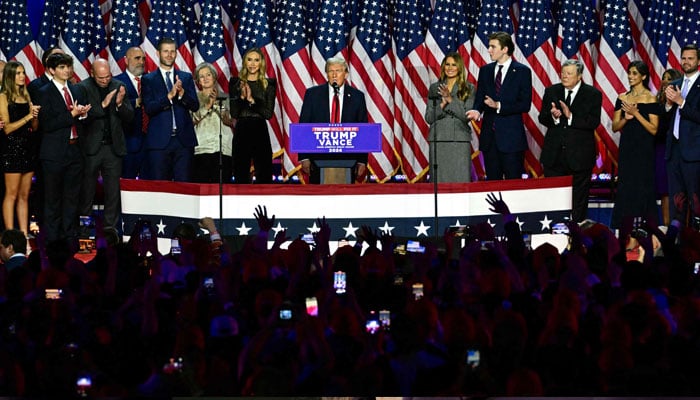
WASHINGTON: Donald Trump’s Republican Party appeared on track Wednesday to win control of both chambers of Congress, giving them sweeping powers for the first time in eight years to implement a broad agenda that includes cutting taxes and spending, deregulating energy and controlling border security.
But it will also force them to confront the dilemma of pursuing a Trump policy plan that could undermine the party’s long-stated goal of reining in the government’s $35 trillion in debt.
Republicans held a 52-48 majority in the US Senate and were on track to expand their narrow majority in the House, although 51 of 435 House races had yet to be called.
Early priorities are expected to include extending Trump’s 2017 tax cuts, funding a wall along the US-Mexico border, cutting unspent funds allocated by Democrats, eliminating the Department of Education and limiting the powers of agencies including the Consumer Financial Protection Bureau, according to the party. Republican. Deputies and assistants.
The tax-cut proposals Trump advanced during his campaign — from extending the 2017 tax cuts to eliminating taxes on tips, overtime and Social Security benefits — could add $7.5 trillion to the country’s debt over the next decade, according to the nonpartisan Committee of Officials. Federal budget.
The federal deficit swelled to $1.833 trillion in fiscal year 2024, as interest on the debt exceeded $1 trillion for the first time.
“We stand ready to work for the American people,” House Speaker Mike Johnson said in an early morning social media post.
Trump has repeatedly proven his ability to drive the party’s agenda during his four years out of power — particularly by demanding that lawmakers repeal a bipartisan immigration bill early this year. Once he returns to the Oval Office, his influence within the caucus will be even stronger.
Republican House Majority Leader Steve Scalise told Reuters that lawmakers have been working with Trump for months to make sure they can begin “an aggressive, bold, conservative first 100-day agenda.”
He said they aim to recreate the economic growth seen early in Trump’s first term, before the COVID-19 pandemic struck in 2020 and sent the economy into a sharp decline.
Republicans point to the booming gains in federal tax revenue since 2017 as evidence that Trump’s tax cuts have raised revenues and say his current agenda will bring more of the same.
“History has shown that when you reduce the overall tax burden on families, not only does it increase their paychecks, but the amount of money coming into the federal government actually increases,” Scalise said. “As long as you control spending, this economic growth will actually provide you with more money to help pay down the deficit.”
But the increase in revenue they point to comes in the form of nominal revenue driven by inflation and the expanding economy. This turns into a decline when the size of the economy is taken into account.
“Trump’s tax cuts actually reduced tax revenues, and what Republicans refer to as massive growth in tax revenues doesn’t actually exist,” said Mark Goldwyn, senior policy director at CRFB.
Legislative obstacles
Over the past two years, members of the House’s unruly and narrow Republican majority have repeatedly gotten in their way, voting against bills supported by their leaders and leaving them dependent on Democratic support to approve must-pass bills.
Even the most disciplined Republican majority will face obstacles, including the Senate rule known as the filibuster, which requires the approval of 60 of its 100 members to pass most legislation, a threshold that the new Senate will not be able to cross with Republican votes alone.
The workaround, known as “budget reconciliation,” allows the Senate to pass budget matters by a simple majority. Republicans used this in the first two years of Trump’s first term, as Democrats did during the first two years of President Joe Biden’s term, when they took control of Congress.
However, budget reconciliation is a limited force. The measures adopted in this maneuver must be at least reasonably linked to revenues and spending.
In late 2021, the Senate parliamentarian rejected Democrats’ attempt to use reconciliation to grant work permits to millions of immigrants living in the United States illegally.
If the 60-vote rule hampers Trump’s priority next year, he could call on Senate leaders to get rid of it, as he repeatedly pressed them to do early in his first term, and as some Democrats urged early in Biden’s term.
Senate Republican leader Mitch McConnell supported the filibuster against Trump’s repeated demands to abandon it during the president-elect’s first term.
McConnell will now step down as leader. While the two top candidates to replace him — John Thune and John Cornyn — have said the base will stay, they and others who might seek that role have not yet faced direct Trump pressure.
McConnell predicted on Wednesday that the filibuster would remain in place.
“I think the filibuster is very safe,” the Kentucky Republican told reporters.
